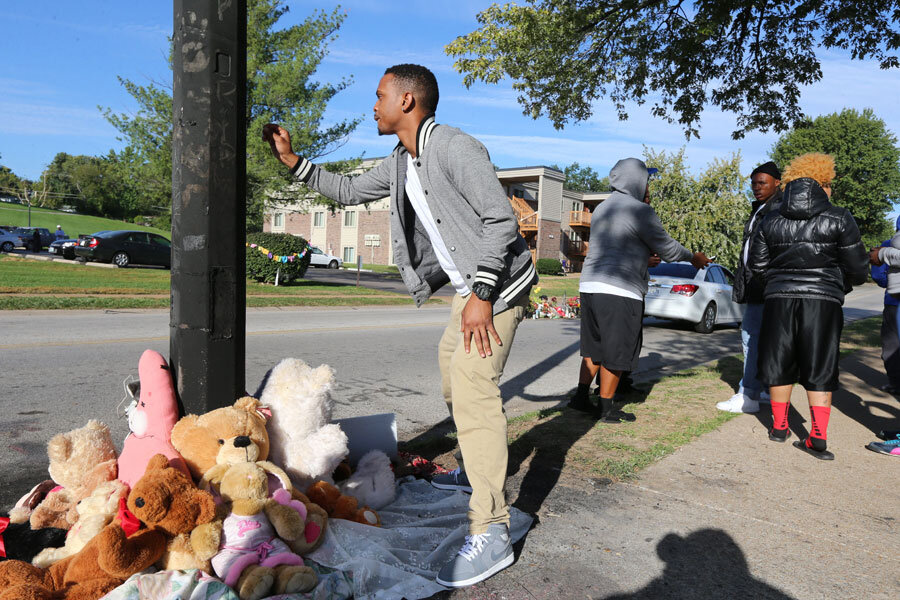Fresh Ferguson protests born of distrust, fueled by resolve
Loading...
Tuesday night, some 200 protesters on West Florissant Avenue again pushed Ferguson, Mo., over the edge of anger and into looting, rock-throwing, and arrests.
At the same time several miles away, the members of the Ferguson City Council were wrestling with the very decisions that some say have pushed members of the city’s black community into believing that they have no choice but to loot, throw rocks, and be arrested.
This time, Ferguson erupted over a fire. One of the three makeshift memorials for Michael Brown, the unarmed black teenager killed by a white cop last month, caught fire Tuesday.
The immediate reaction of some residents was suspicion. “We know it wasn’t an accident,” one protester told KSDK-TV.
That suspicion speaks to a deep distrust that spilled over but did not begin with Mr. Brown’s shooting. The actions of the city council started to address those deeper causes Tuesday.
But in Ferguson, where the town officials are nearly all white, and the population is nearly 70 percent black, the dynamic of power is peculiar, says Pamela Oliver, who studies social and protest movements at the University of Wisconsin in Madison.
She likens it to the dynamic of an occupied territory, with a breakdown in trust between the governing and the governed. Tuesday night showed that the city’s African-Americans are “fighting back,” and the city’s white power structure should take note, says Professor Oliver.
“It’s long been known that people often endure oppression, and the moment of standing up is not necessarily that the oppression has shifted, it’s rather some sort of signal that, 'Now is the time,' " she says.
Ferguson’s municipal court system, which provides millions to the city’s general revenue, included a fee and fine system that resulted in small tickets growing exponentially into major expenses that many people couldn’t pay, thus raising the specter of possible jail time. Minorities also felt they were disproportionately targeted by police.
On Tuesday, the council capped the total percentage of court fines that can go into the general fund at 15 percent and changed the fee and fine system. But it also put aside a proposal to establish a civilian oversight committee for the police department.
In late August, Ferguson Mayor James Knowles, who is white, told MSNBC that “there’s not a racial divide” in Ferguson and added, “that is the perspective of all residents in our city, absolutely.”
Mayor Knowles has stood by the comments, though a communiqué from city officials distributed at a community forum on Monday pointed to an apparent divide: “We are not targeting African-Americans. [But African-Americans] make up the majority of our community … so most people being pulled over will be African-American. Having said that, we are not trying to ignore the need for better relations with the African-American community, and we believe the more we are involved in the community the more likely it is that we’ll earn African-American citizens’ trust back.”
Residents at the meeting said divisions in the community were laid bare. “The racial tension in this room, you can’t even cut it with a saw,” resident Cierra Douglas told the St. Louis Post-Dispatch.
Protesters have repeatedly called for the police officer who shot Mr. Brown to be arrested. They say he raised his hands in surrender before he was shot. A grand jury has until Jan. 4 to either return an indictment or conclude that Officer Darren Wilson acted within the law.
It’s not clear how the memorial burned Tuesday, but the length of the investigation and a perceived lack of transparency about what evidence police have seems to be fueling the unrest. Five people were arrested after breaking windows and throwing rocks at police.
“The potential for violence and volatile protests will continue until some definitive action is taken,” says Aldon Morris, a sociologist at Northwestern University who studies black social movements. “Clearly, the black community does not trust the police, and young people in Ferguson feel that the powers that be are simply stonewalling … hoping that unrest will dissipate … because they want to exonerate the policeman.”
The sudden flare-up of protest on Tuesday sends a signal that anger is not abating, says Mr. Morris.
“The sense among young people is that this is now on them and their generation, and they are going to confront it the way they think best,” he says.








